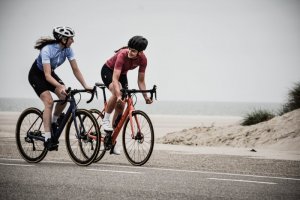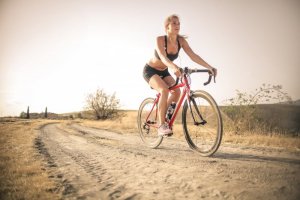
Are you gearing up for an unforgettable bike adventure? Whether you’re planning an intensive biking tour or just want to squeeze some cycling into your weekend getaway, preparation is key. And we’re here to help you know exactly what to prepare for. In this helpful guide, we’ll walk you through setting realistic goals so you can enjoy your biking trip even as a complete beginner. We’ll help you get to grips with training, plan for the weather, and more. Here’s your guide to preparing for a cycling trip.
Physical preparation for an intensive bike trip
A bike trip, whether a leisurely weekend getaway or an intensive biking tour, demands a certain level of physical preparedness. It’s not just about having the right gear and knowing your route; your body must be up to the challenge.
Assessing your fitness level
 Before you hit the road, it’s crucial to take stock of your current fitness level. Are you a seasoned cyclist or more of a casual rider? Understanding where you stand will help you set realistic goals for your trip. When preparing for your upcoming bike trip, it’s crucial to get a clear picture of your current fitness level.
Before you hit the road, it’s crucial to take stock of your current fitness level. Are you a seasoned cyclist or more of a casual rider? Understanding where you stand will help you set realistic goals for your trip. When preparing for your upcoming bike trip, it’s crucial to get a clear picture of your current fitness level.
Start by thinking about your recent biking experiences, including the kinds of terrain and distances you’ve comfortably tackled in the past. Even if you have limited experience, that’s perfectly fine. The key is to be honest about your abilities so you can plan a bike trip that suits you best. Whether you’re an experienced or casual cyclist, understanding your limitations is the first step to creating an enjoyable and manageable cycling trip.
Setting realistic biking goals based on your fitness
Choose a distance and terrain you can comfortably handle. Take a holistic approach by considering the entire itinerary. While it can be exciting to push your cycling limits, ensure you reserve enough energy for other activities on your agenda. If your trip is solely a biking trip, remember to include planned rest stops and breaks to prevent burnout. It is also important not to let the avid cyclists set the plan for the whole group. Consider everyone’s ability to ensure the whole group has an enjoyable time.
Training plan
Once you’ve assessed your fitness level, it’s time to create a training plan tailored to your needs. Training is not just for professional athletes but anyone who wants to enjoy their bike trip to the fullest. You may need a finely tuned training regime if you have an intense trip planned or if there’s a significant gap between your current ability and where you need to be.

However, for most people, you only need to do one thing (broadly speaking): put in the miles on the bike. There is no better training for cycling than cycling. Strive for consistency and push yourself a little bit to maximise the reward. It can be tempting to substitute cycling for swimming or running. Both are amazing and will undoubtedly help, but you’ll get the biggest returns from time on the bike. If you’re a less experienced cyclist, this will also help you get used to handling your bike and sitting in the saddle for longer stretches.
Prepare for the elements
If possible aim to train in similar conditions to what you will experience on your trip. It may not be possible to find the exact terrain but aim to find something close. Another crucial factor to consider is the weather. Look ahead to the forecast and try to replicate the conditions you expect. If it’s likely to rain on your trip, cycle in the rain to get used to your wet weather gear and how your bike handles.
If you anticipate the trip to be warm, try to fit your cycling in on hot days or ride at midday when it’s warmest. Training in this way will maximise your preparedness. Don’t get caught out by riding in wet conditions or tackling the heat for the first time on your trip.
Transporting your bikes
You’re all prepared physically. You’ve planned out your cycling activities, trained and even rode in the rain to get used to it – you’re up to the challenge. But you can’t have a biking trip without bikes. If you’re a camping enthusiast or frequent outdoor adventurer, you will know that packing can be a hassle. Before your trip can even begin you need to bundle tents, hiking gear, or fishing equipment into your car. So, how do you get your bikes from A to B?
Use a cycle carrier
Attempting to fit your bikes inside your vehicle can quickly turn into a logistical nightmare. This is where bike racks and cycle carriers come to your rescue. These aren’t mere conveniences; they’re game-changers. Firstly, they free up valuable space inside your vehicle, giving you space for all your other gear (and passengers). Secondly, they ensure your bikes are securely fastened during transit, protecting them from being damaged.
But cycle carriers are not one size fits all, and which is best for you will depend on a few factors, including how many bikes you need to hold, your vehicle, and more. Check out this cycler carrier buyer’s guide for help choosing the best cycle carrier for your needs.
 Get the most from your biking trip
Get the most from your biking trip
Cycling is an incredible activity. Whether you’re an experienced cyclist or just dipping your toes into the hobby, preparation is essential to having the best time on your bike. From setting realistic goals and training for the right terrain and weather to the logistics of moving your bikes, there’s a lot to plan for. But the planning is all worth it.
Follow the tips in this guide, and you’re sure to get the most from your biking trip.
Your thoughts on preparation for a cycling trip?
What has been your approach? Or are you thinking of planning for a trip currently as part of your vacation? Let us know your experience and ideas in the comments below.

Sponsored Post Towbar Express
Towbar Express is the UK’s largest towbar fitting company, providing professionally fitted towbars at work or on your driveway. We have been in business for over two and a half decades and fit a range of towbars and cycle carriers. We have a fleet of vans covering England (and parts of Wales), so a member of our mobile towbar fitting team is always nearby.














Leave a Reply